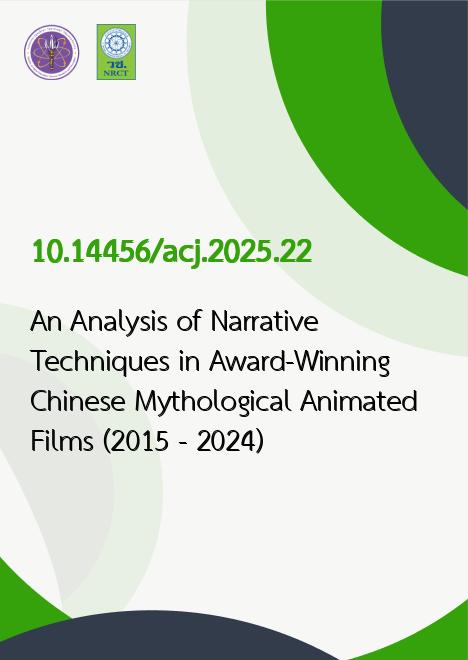
|
An Analysis of Narrative Techniques in Award-Winning Chinese Mythological Animated Films (2015 - 2024) |
|---|---|
| รหัสดีโอไอ | |
| Creator | Rui Wang |
| Title | An Analysis of Narrative Techniques in Award-Winning Chinese Mythological Animated Films (2015 - 2024) |
| Contributor | Chakapong Phaetlakfa, Porawan Pattayanon |
| Publisher | The Office of Arts and Culture, Surindra Rajabhat University |
| Publication Year | 2568 |
| Journal Title | Arts and Culture Journal of the Lower Moon River |
| Journal Vol. | 14 |
| Journal No. | 2 |
| Page no. | 295-309 |
| Keyword | Award-Winning Chinese Mythological Animated Films, Narrative Techniques, 2015 - 2024 |
| URL Website | https://so07.tci-thaijo.org/index.php/acj |
| Website title | วารสารศิลปะและวัฒนธรรมลุ่มแม่น้ำมูล |
| ISSN | ISSN 2822 - 0617 (Online);ISSN 2822 - 1141 (Print) |
| Abstract | Although Chinese mythological animated films have gained increasing attention, few studies systematically examine their narrative techniques in a modern cultural context. This study fills the gap by analyzing ten award-winning Chinese mythological animated films released between 2015 and 2024, selected based on criteria of awards and recognition, market performance, diversity in themes, production technology and innovation, and cultural influence. Grounded in narrative theories by Seymour Chatman, David Bordwell, and Li Xianjie, the research adopts a six-element framework including story and plot, time, space, character development, narrator, and narrative systems. Using qualitative methods, including textual analysis and in-depth interviews with animation professionals and scholars, the study reveals a three-phase evolution including the exploratory phase (2015 - 2016), the narrative maturation phase (2019 - 2020), and the stylistic hybridization phase (2021 - 2024). These works reveal increasing complexity in temporal structures, symbolic space, and narrative perspective, shifting from omniscient to subjective storytelling. Notably, heroic themes dominate this genre, responding to both state-driven cultural discourse and the psychological needs of younger audiences confronting identity challenges. The study argues that the success of these films lies in their ability to reframe traditional mythology through emotionally resonant, aesthetically diverse, and culturally adaptive storytelling. By decoding how myth is rearticulated through contemporary animation, this research contributes to the localization of narrative theory and provides practical implications for scholars and creators focused on visual storytelling in modern Chinese culture. |